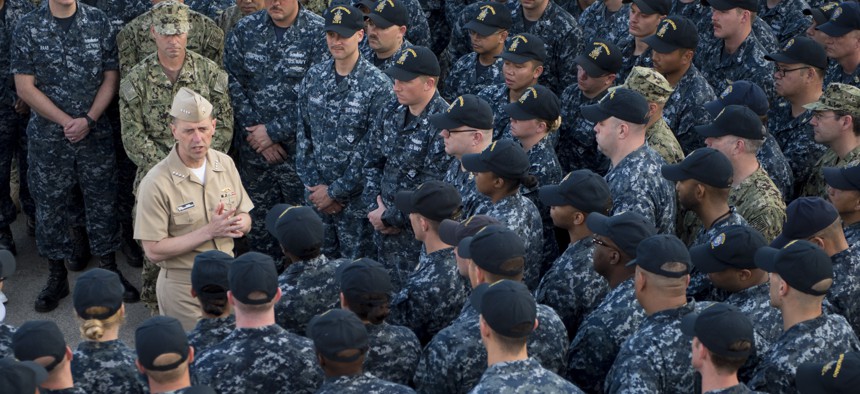
Chief of Naval Operations Adm. John Richardson holds an all-hands call aboard the littoral combat ship USS Coronado (LCS 4), pierside in Singapore on May 16, 2017. U.S. Navy / Mass Communication Specialist 1st Class Nathan Laird
CNO: We Need a Bigger, Better Fleet Far Sooner Than You Think
Adm. John Richardson lays out an urgent vision for meeting the 21st century’s sail-to-steam moment.
New technologies — autonomy, networking, 3D printing, and more — are changing naval warfare “like moving from sails to steam, wooden ships to iron hulls, like the advent of nuclear propulsion,” and the U.S. Navy needs to move a lot faster to keep up, says Chief of Naval Operations Adm. John Richardson.
“The pace at which potential competitors are moving demands that we in turn increase the speed at which we act” to develop a larger and more capable fleet, Richardson writes in a much-anticipated white paper. “We need this more powerful fleet in the 2020s, not the 2040s.”
Richardson spoke to reporters Monday, ahead of the Wednesday release of the nine-page white paper. He alluded to recent think-tank reports plus a Navy-led one that have argued for a fleet of about 355 ships, far more than the current 275 and, indeed, the three-decade target of 308.
“More numbers are necessary, but not sufficient,” he said by phone from Singapore. “We need a bigger fleet but a different fleet.”
RIchardson said all future ships must be built to accept upgrades with ease and alacrity. New designs should include a hull and powerplant that will last a service lifetime, but “the rest of the ship, we’ll build to modularize and modernize.”
Didn’t the Navy try that with its littoral combat ships, now plagued by breakdowns and far short of the modularity vision?
“LCS was very complex,” Richardson responded. “The technology has come to the point where we can do that with much more agility. Even in LCS, we’ve done a lot to decomplexify operations, with new crewing and operational concepts.”
In the white paper, he writes that the U.S. industrial base has the capacity to build 29 more ships and some 300 more planes than currently planned over the next seven years. But at what cost? In February, the Congressional Budget Office reported that the Navy’s 30-year shipbuilding plan — the one that gets to 308 ships by 2046 — would cost an extra $5 billion a year. That’s about one-third more than current budgets allow.
Richardson declined to say how much his accelerated plan would cost, saying only that he thought the total would be “far less than CBO predicted, but more than we have in traditional [shipbuilding] accounts.”
How will that be possible? By rethinking everything, he suggested: building ships more cheaply, extending the life of today’s ships and aircraft, and boosting the capabilities of existing ships, planes, submarines, and unmanned vehicles through networking, robotics, and more.
“We need to challenge the assumptions,” the CNO said. “Linear approaches are going to get us to this [future] navy too late.”
That sounds a little like the approach fostered by the Defense Department’s Strategic Capabilities Office, which works with the services to give existing weapons “surprising new capabilities,” in the words of former Defense Secretary Ash Carter. Much of the SCO’s work remains classified — that would be the “surprise” part — but its poster child is a naval project: retrofitting the SM-6 anti-air missile to sink ships.
History suggests big surges in naval shipbuilding don’t last more than a few years. Reagan’s naval buildup didn’t outlast his first term, one reporter noted on the conference call.
Richardson’s response: “It lasted only three years, but we’re still coasting on that surge.”




